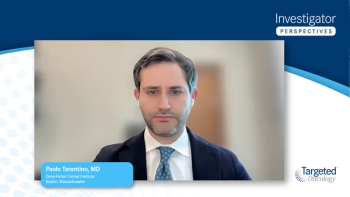
Considerations in Choosing Venetoclax for AML
An expert describes the considerations in choosing to treat acute myeloid leukemia patients with venetoclax.
Daniel Pollyea, MD, MS: Venetoclax plus HMAs [hypomethylating agents] are incredibly effective therapies for newly diagnosed unfit patients with AML [acute myeloid leukemia], but there are important considerations that must be taken for these patients. In particular, in the initiation of the therapy, tumor lysis syndrome can occur. Those of you who treat CLL [chronic lymphocytic leukemia] with venetoclax know about this and take extraordinary precautions to mitigate or prevent this from happening. It doesn’t appear that the incidence is anywhere near the same in AML with venetoclax-based regimens. In fact, it’s probably only around 1%. But you have to remember that those numbers came into existence in the setting of very aggressive mitigation strategies that were done in the clinical trial setting—admission for the patient, interrupt patient dose escalation from 100 to 200 to 400 mg on days 1, 2, and 3 for venetoclax with an HMA, very aggressive fluid management and electrolyte management. With those aggressive mitigation techniques, the incidence of tumor lysis is quite low in AML, but it’s something that folks are aware of.
Another issue with venetoclax-based regimens are cytopenias. Cytopenias occur with almost every treatment we have for patients with AML. An HMA alone has a considerable incidence of cytopenias. Venetoclax is somewhat myelosuppressive and can contribute to or worsen these numbers. But with careful attention, this doesn’t necessarily have to impact a patient’s clinical status in terms of having more bleeding or infectious complications. The main way to mitigate this is to take breaks between treatment cycles.
After the first cycle of therapy with venetoclax plus an HMA, it’s important to check a bone marrow biopsy. This isn’t like just giving an HMA alone, where you can wait 4 to 6 months or 4 to 6 cycles to check a bone marrow biopsy. One must check a bone marrow biopsy after cycle 1 because you would do things differently if the patient is not in a remission and they are cytopenic because of that. You’d have an array of decisions to make. You might want to just go right into a second cycle because the blast percentage has come down considerably but they’re not yet in a remission. Or you might want to move on from this therapy and try something different if it doesn’t seem like it’s working. That would be very different from knowing that after cycle 1 the patient is cytopenic but the blasts are gone. They’re in a morphological remission. If that’s the case, it’s very important not to go right to the next cycle.
It’s very important to take a break and give upward of 2 weeks off therapy to allow blood counts to recover. Sometimes giving growth factor support to hasten that recovery is a fine thing to do. But taking those breaks between cycles is critical to manage the cytopenias. If that isn’t done, the cytopenias will become significant and very difficult to manage. Then you’ll begin to have clinical manifestations with respect to infectious or bleeding complications. In terms of venetoclax plus HMA, those are 2 of the biggest toxicities or considerations that folks need to be aware of. But the message should be that these are manageable complications.
In my practice, this is the treatment of choice for all newly diagnosed patients with AML who were unfit for intensive induction chemotherapy. Even very frail, older patients should be given a chance to see if they can respond to this regimen. With aggressive supportive care, I find that even the most frail or older patients can get through this and have a chance at a remission. You wouldn’t use this combination for patients who can’t absorb an oral medication for whatever reason. With patients who were treated with an HMA for MDS [myelodysplastic syndromes] and then evolved to acute leukemia, you might want to use venetoclax plus low-dose cytarabine instead, because the VIALE-C study, which looked at venetoclax plus low-dose cytarabine vs low-dose cytarabine alone, and also resulted in the approval of that regimen, included those types of patients. Patients with MDS who received an HMA alone and then progressed and had AML were included in VIALE-C, so that might be a consideration in that setting.
Beyond the labeled indication for venetoclax, there are other populations of patients in which venetoclax-based regimens can be promising. In off-label use for patients with relapsed/refractory AML, there appears to be some efficacy that’s exciting. The same goes for patients with myelodysplastic syndromes. Both have ongoing clinical trials. The third population is patients who would be eligible candidates for intensive induction chemotherapy but have disease biology that would suggest a worse response to this type of approach. The patients with adverse disease biology, complex cytogenetics, maybe those with mutations in RUNX1 or ASXL1, would be predicted to have poor outcomes to intensive chemotherapy strategies but not necessarily to venetoclax-based strategies. Those are patients in whom you could consider the use of a venetoclax-based regimen, even in a patient who would be eligible for intensive induction chemotherapy. It’s important to say that it would be an off-label treatment for venetoclax.
Unfortunately, the cost of medicine is an issue that impacts our patients all the time. These are expensive medications, and we sometimes struggle getting them approved or getting the co-pays for these expensive oral therapies affordable. There are assistance programs and grants that can help with this. Patient affordability is a potential barrier. This is a problem for all of society to work on. But there are some resources out there that can help with this.
Transcript edited for clarity.






































